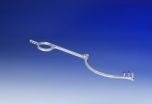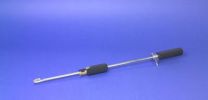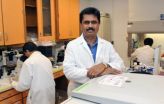(Press-News.org) Be it a heart transplant or a Cesarean section, every operation requires a wide variety of surgical instruments, from simple retractors, clamps, scalpels and scissors to more specialist devices such as cerclage wire passers, which surgeons employ to repair long, oblique fractures in bones. These are shaped in such a way as to half encircle the broken bone, and incorporate a hollow channel. In a process not unlike stringing a parcel for posting, thread or wire is fed through the channel around the damaged bone and then knotted in place, both to support the bone and to hold the broken parts together. "Until now, it has always been time-consuming and expensive to manufacture surgical instruments featuring this kind of channel," says Claus Aumund-Kopp of the Fraunhofer Institute for Manufacturing Technology and Advanced Materials IFAM in Bremen. Because it is nigh-on impossible to machine curved channels, shaped tubes have traditionally had to be cast, or else welded or soldered retrospectively.
At the MEDTEC Europe trade show in Stuttgart from March 22 through 24 (Hall 6, Booth 6211), the Bremen-based scientists will be presenting a technique that enables the manufacture of surgical instruments of any shape, even those with complex interiors like channels, or those with integrated RFID chips. The technique in question is laser melting. Originally developed for the production of industrial prototypes, this manufacturing method uses an extremely fine laser beam to melt a powder material into almost any desired form, one layer at a time.
"Nowadays, laser melting is a mature technology, which has already proved its worth
in the manufacture of medical implants," states Aumund-Kopp. Like all generative – i.e. bottom-up – manufacturing techniques, it has two major advantages: First, unlike in turning, drilling or milling, hardly any material is wasted; and second, there are no production-related restrictions on the shape or interior structure of the workpiece. "The designer can focus exclusively on the surgeon's stated requirements," says the engineer. For surgical instruments, either cobalt-chromium steel or titanium powders could be used – both are standard materials in generative manufacturing. Although no-one has yet begun using the laser melting technique to produce surgical instruments, Aumund-Kopp believes it would be an ideal manufacturing method: "Even small quantities of customized surgical instruments incorporating completely new functions could easily be produced in this way," he reports. 3-dimensional model on a computer is the only template needed; intermediate stages, including the production of special tools or casting molds, are eliminated.
Steel components that are produced using laser melting technology also demonstrate particular electrical properties. Normally, metals shield against electromagnetic radiation such as radio waves, so whenever an RFID chip is cast in metal, a small opening must be left above it, otherwise it will not be readable. But this is not necessary with laser-melted instruments; even though they are completely shrouded in metal, the integrated RFID chips are still able to transmit and receive over short distances. "We assume that the layered structure of the material shapes the field in such a way that the chips remain readable despite their metal covering," explains Aumund-Kopp. This could prove advantageous in the operating room: After every operation, all surgical instruments have to be cleaned, sterilized and counted; if they had integrated RFID chips, quantities and individual numerical codes could be checked quickly and easily and could be electronically linked to the operation report or to specific instrument data such as date of manufacture, protocols for use or current state of cleanliness.
INFORMATION:
Surgical instruments with electronic serial numbers
2011-03-01
ELSE PRESS RELEASES FROM THIS DATE:
Minimally invasive surgeries: Laser suturing
2011-03-01
More and more often, abdominal surgeries are being carried out in a minimally invasive manner. A small incision in the abdominal wall is sufficient for the surgeon to be able to insert the instrument and make the organs visible with an endoscope. This technique is gentler and does not stress the body as much as traditional surgeries do. However, these minimally invasive surgeries pose a special challenge to the surgeons. In particular, the suturing – meaning joining the tissue with needle and suture material - demands great skill and dexterity. Very often, piercing the ...
U. Iowa team investigates function of 'junk DNA' in human genes
2011-03-01
Part of the answer to how and why primates differ from other mammals, and humans differ from other primates, may lie in the repetitive stretches of the genome that were once considered "junk."
A new study by researchers at the University of Iowa Carver College of Medicine finds that when a particular type of repetitive DNA segment, known as an Alu element, is inserted into existing genes, they can alter the rate at which proteins are produced -- a mechanism that could contribute to the evolution of different biological characteristics in different species. The study was ...
Compound useful for studying birth defects may also have anti-tumor properties
2011-03-01
In an interesting bit of scientific serendipity, researchers at North Carolina State University have found that a chemical compound useful for studying the origins of intestinal birth defects may also inhibit the growth and spread of cancerous tumors.
During the screening of chemical compounds created by NC State chemist Dr. Alex Deiters, developmental biologist Dr. Nanette Nascone-Yoder found one of particular interest to her research: a compound that induced heterotaxia, a disordering or mirror-image "flipping" of internal organs, in the frog embryos she was studying. ...
Blood pressure management: Sleep on it
2011-03-01
A daytime sleep could have cardiovascular benefits according to new research by Ryan Brindle and Sarah Conklin, PhD, from Allegheny College in Pennsylvania in the US. Their study, looking at the effect of a daytime nap on cardiovascular recovery following a stress test, found that those participants who slept for at least 45 minutes during the day had lower average blood pressure after psychological stress than those who did not sleep. The work is published in Springer's journal International Journal of Behavioral Medicine.
Long work schedules, shift work, increased anxiety ...
IDIBELL researchers discover a substance against the 'dark genome' of cancer
2011-03-01
A research study coordinated by Manel Esteller, researcher at Bellvitge Biomedical Research Institute (IDIBELL) has identified a substance that inhibits cancer growth by activating the so‑called "dark genome" (or non‑coding DNA) and micro‑RNA molecules. The study appears this week in the journal Proceedings of the National Academy of Sciences (PNAS).
Human body cells have a genome (the set of our DNA) encoding our proteins such as keratin in the skin or haemoglobin in blood. This genome with encoding DNA represents only the 5% of our genetic material. ...
University of Cincinnati research presented at international criminal justice meeting
2011-03-01
About 1,200 criminal justice researchers as well as active and retired law-enforcement professionals from around the world are expected to attend the annual meeting of the international Academy of Criminal Justice Sciences, to be held March 1-5 in Toronto. Presentations of the latest research in the field will be made, including research presented by the University of Cincinnati faculty and students.
Recognized at the conference will be UC researchers Bonnie Fisher, professor, and Francis Cullen, distinguished professor. Fisher and Cullen will receive the 2010 Outstanding ...
BUSM study shows chemoradiotherapy prior to surgery improves survival
2011-03-01
Researchers from Boston University School of Medicine (BUSM) have found that patients with node negative T3 and T4 non-small lung cancer who underwent chemotherapy before surgery had more than three times the survival rate than patients who only underwent surgery. These findings currently appear on-line in the Journal of Thoracic and Cardiovascular Surgery.
The study looked at a total of 110 patients who underwent surgical resection for invasive T3 and T4 non-small lung cancer between 1979 and 2008. Forty-seven patients received neoadjuvant chemotherapy and concurrent ...
ISU research raises hope for solving Parkinson's disease puzzle
2011-03-01
AMES, Iowa - A protein pathway that may hold the secret to understanding Parkinson's disease has been discovered and explained by Iowa State University researchers.
Anumantha Kanthasamy, a distinguished professor of biomedical sciences and the W. Eugene and Linda R. Lloyd Endowed Chair in Neurotoxicology at the ISU College of Veterinary Medicine, has been working to understand the complex mechanisms of the disease for more than a decade. He believes this recent discovery offers hope for the cure.
The research was funded by the National Institutes of Health and is published ...
Study finds close linkage between a rare, deadly lung condition and blood cell abnormalities
2011-03-01
WASHINGTON, February 28, 2011) – Results from a study published in Blood, the Journal of the American Society of Hematology reveal a close relationship between pulmonary arterial hypertension (PAH)—exceedingly high blood pressure in the arteries carrying blood from the heart to the lungs—and abnormalities of the blood-forming cells in the bone marrow (known as myeloid abnormalities).
The study, which was conducted by a team of researchers at the Cleveland Clinic, showed that blood progenitor cells (cells that are capable of forming white blood cells, red blood cells, ...
U. of Colorado study shows acupressure effective in helping to treat traumatic brain injury
2011-03-01
A new University of Colorado Boulder study indicates an ancient form of complementary medicine may be effective in helping to treat people with mild traumatic brain injury, a finding that may have implications for some U.S. war veterans returning home.
The study involved a treatment known as acupressure in which one's fingertips are used to stimulate particular points on a person's body -- points similar to those stimulated with needles in standard acupuncture treatments, said CU-Boulder Professor Theresa Hernandez, lead study author. The results indicate a link between ...




